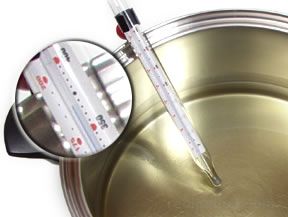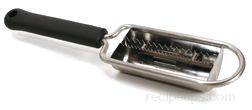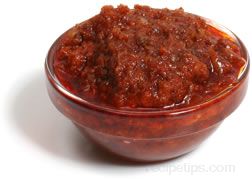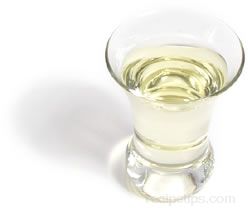|
Contamination Prevention | Cooking Safety | Proper Storage
Cleanliness: A clean working environment is essential in the prevention of contamination when working with fish. Be sure to wash hands thoroughly before and after handling raw fish. The work area, cutting boards, and utensils must be thoroughly cleaned with hot soapy water after being exposed and should not be used for other foods until properly cleaned. This will prevent cross contamination of bacteria from the fish to other foods. When working with other foods at the same time as preparing and cooking fish, be sure to use different utensils for each food. Do not use the same platter for cooked fish as was used for the raw meat, unless it has been properly washed and dried before using. If any preparation of the fish is done on a cutting board, it should be thoroughly scrubbed with hot soapy water after each use and periodically cleaned with a bleach solution consisting of 1 tablespoon of bleach per gallon of water. Handling Market Fish: Fresh or frozen fish should be purchased just before leaving the market so it is exposed to unsafe temperatures for as short a time as possible. It should be placed in a plastic bag to prevent any leakage from contaminating any other foods. Bring a cooler along to store the fish in while traveling home or pack the fish in ice. To maintain the quality of the fish, it needs to be kept at a temperature under 40°F. Do not allow the fish to set in a hot vehicle for any length of time unless stored properly. After purchasing it should be taken home and refrigerated as soon as possible. When cooking and serving fish, the meat must be handled properly to prevent contamination. Use a different platter and cooking utensils for cooked fish than what was used for the raw fish, unless they have been properly cleaned and dried after exposure to the raw fish. Be sure the raw fish does not come in contact with foods that have already been cooked or foods that do not require cooking before being consumed, such as raw vegetables and fruit. If taking cooked fish to be served at another location, be sure to pack the fish so it maintains the proper temperatures. If you are keeping it hot, it should maintain at least a 140°F temperature and if it is cold, it must be kept at or below 40°F. Handling Fisherman's Catch: Keeping your daily catch safe from bacteria can be a challenge unless you are ice fishing. See the tips below for warm weather fish handling.
It is necessary to cook the fish completely to eliminate the chance of food borne illness. The safest manner in which to check for doneness is to check the internal temperature with a meat thermometer in several locations. Internal temperature should be a minimum of 145°F when checked in the center of the thickest area of the fish. If a meat thermometer is not available, check for doneness by using a fork to check if the fish flakes easily and to see if its appearance is opaque and not translucent and raw looking. Deep-Frying Safety Deep-frying, also known as deep-fat frying, is a popular cooking method used for fish. It is a process of immersing food in a pan containing hot oil, which cooks the food quickly, producing a crispy surface covering a tender and moist interior. Because of the large quantity of hot oil that is used for deep-frying fish, there are some safety concerns that must be considered when using this cooking method. The safety concerns are listed below.
Checking the Temperature of the Oil: A temperature between 350°F and 375°F is an ideal range for deep-frying. The correct temperature can be determined with the use of a candy thermometer. Another method that can be used is to place a cube of bread into the oil and if it browns in 45 to 50 seconds, the oil is at the correct temperature. The oil should not need to reach over 375°F to fry the fish. Oil above this temperature will brown the fish too quickly, not allowing it to cook properly all the way through. The undercooked fish poses a safety concerns. Any cooking oil can be used for deep-frying provided it does not smoke or burn at temperatures that may reach as high as 375°F. For a healthier choice, oil low in saturated fat is best to use because the food will absorb a small quantity of oil during the cooking process. Refrigerating | Freezing | Super-Chilling | Freezing Tips Properly preparing fresh fish for storage will allow it to be stored for a longer period of time and maintain its quality. Fresh caught fish should be gutted and cleaned as soon as possible and then stored at the proper temperature until ready to cook. For the best flavor and quality, fish should be prepared for eating within 24 hours of catching but if stored properly it is safe to keep refrigerated for 2 to 3 days. Fresh caught or market fresh fish should be stored at a temperature 40°F or below and cooked fish should be kept at a temperature 140°F or higher to keep it outside of the temperature zone in which bacteria, that causes food borne illness, grows quickly. The danger temperature zone is a range between 40°F and 140°F. Raw fish can be stored in a refrigerator for 2 to 3 days. Leftover cooked fish can be stored for up to 3 or 4 days. If raw or cooked fish is not going to be used within the recommended time, it should be frozen to prevent it from perishing. Refrigerating Raw fish can be stored safely in a refrigerator at 40°F or lower for 2 to 3 days. Oily fish will store longer than lean fish and whole fish will store better than steaks and fillets. There are several factors listed below that will have an affect on how well the fish will store.
Follow the instructions below to store fresh fish in the refrigerator properly.
Cooked Fish Leftovers: Cooked leftovers should be cooled and refrigerated as soon as possible, limiting the amount of time the fish is exposed to room temperatures. Never leave the fish at room temperature for more than two hours. Store it in a shallow covered container to allow the fish to cool to the proper temperature more quickly. Cooked fish can be stored for up to 2 to 3 days in a refrigerator at 40°F or less. If leftovers are not going to be used within this time, they can be frozen and stored for up to one month. Fresh fish can be stored at 40°F or less for 2 to 3 days but if it is not going to be used within that time, it should be frozen to prevent it from perishing. Freeze the fish while it is as fresh as possible. Proper handling of the fish is also necessary to produce a quality frozen product. The same factors stated above will have an affect on the quality of the fish when it is frozen. Be sure the fish has been cleaned properly before freezing. There are several methods that can be used for freezing fish. The method you select may depend on if you are freezing whole fish, large cuts, steaks or fillets. Also, take into consideration how much freezer storage room you have available. Fish should be frozen in a freezer at 0°F or less. Several methods are shown below. Double Wrapping: This method works well on smaller whole fish, steaks and fillets. It saves freezer storage space and the individual pieces thaw easier when you are ready to use them.
Freezing in a Block of Ice: This method works well for smaller pieces, such as steaks and fillets. Freezing in a block of ice protects the fish from being exposed to any air because the air cannot penetrate through the ice. This guards the fish against freezer burn. This method requires more room in the freezer for storage and is a little more work when it comes to thawing the fish.
Glazing: This method works well for whole fish or large cuts. Glazing seals the fish with a thick layer of ice to protect it from exposure to air. Once the fish have been glazed they will require less freezer space.
When using any of the freezing methods, be sure to mark the packages with contents and the date so you can be certain of how long it has been stored in the freezer and what it contains. Be sure all wrapped packages are sealed tightly and any fish frozen in ice is completely covered with ice to prevent ice crystals from forming on the fish. Ice crystals form because moisture has been drawn out of the fish, causing it to become freezer burned. Freezer burned areas of the fish become distasteful and tough or dried out. Store bought frozen fish should be left in the original package and place in the freezer as soon as possible. For extra protection place the store bought package in a freezer bag before placing in the freezer. Freezing Cooked Fish Leftovers: If you have cooked fish leftovers that are not going to be eaten within 2 or 3 days, you can freeze them for extended storage. Place the cooked fish in shallow covered container to allow the fish to freeze more quickly. Cooked fish can be stored in the freezer for up to one month. It is always best to freeze and store frozen food in a freezer unit, rather than a refrigerator freezer. The freezer units will maintain a temperature of 0°F or below, which will allow food to be stored for longer periods of time. A refrigerator freezer will generally only maintain a temperature of 10°F to 25°F and is opened more often, which causes fluctuation in temperature. If fish is stored in a refrigerator freezer, it should be used within one to two months. The chart below shows storage times for fish when stored in a refrigerator or freezer.
Super-Chilling fish is a good method of storing fish that needs to be transported a distance when freezing capabilities are not available. If stored properly, fish can be kept fresh for up to 6 or 7 days. See instructions below for super-chilling.
Today there is considerable concern regarding the PCB and mercury levels of the water in which the fish live, thus raising the PCB and mercury levels found in the meat of the fish. Consequently, fish are beginning to be listed into groups of species that should be consumed and species that should be avoided. It is generally agreed that most farm-raised varieties of fish are safe to eat (farm raised salmon are an exception because they typically require significant amounts of mackerel, herring, and other fish as feed, however, if the source is dependable and uses environmentally sound practices, then farm raised salmon can be considered safe to consume). The charts below list the fish varieties harvested in their natural habitat that are considered safe and those that are questionable or known to be unsafe.
Mercury affects the development of cognitive, motor, and sensory functions in the brain. It is especially harmful to unborn children and young children. The more mercury a person takes in its body and the longer the exposure time to the mercury, the more serious the affects can be. This is why unborn children and young children run more of a risk. The FDA advises that young children, pregnant women, women of childbearing age who may become pregnant, and nursing mothers should not consume fish that are known to have high levels of mercury. The FDA suggest that the pregnant women and nursing mothers also limit the amount of low mercury level fish to 12 ounces per week. The EPA suggests even a more strict limit on low mercury level fish, which is 8 ounces of uncooked (6 ounces cooked) fish one time per week and only 3 ounces of uncooked (2 ounces cooked) fish one time per week for young children. Men and women outside of this group should also limit the amount of fish with high levels of mercury to occasional consumption. Variables such as, the ability of a persons body to tolerate mercury, the level of mercury in the fish, how much fish is consumed, and the body weight of the person consuming the fish will all have an affect on the risks of the mercury consumption. | ||||||||||||||||||||||||||||||||||||||||||||||||||||||||||||||||||||||||||||
Loading
Fish Handling, Safety & Storage

Read Reviews (2)

Provided By
RecipeTips
RecipeTips
Reviewed By gigs
"I appreciate the information on storing fish. When we go fishing and bring home ... read full review"
"I appreciate the information on storing fish. When we go fishing and bring home ... read full review"

Loading
fish handling safety and storage
:

Reviewed By gigs
"I appreciate the information on storing fish. When we go fishing and bring home fresh fish I always wonder what the best way to store it is and for how long can I store it. This article was very informative."

Reviewed By RTMember7047
"This is the first article I've been able to find about safely freezing prepared fish."
Advertisement
Advertisement

















